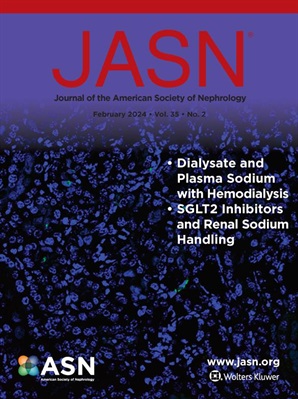靶向补体减轻肾移植缺血再灌注损伤的基本原理。
IF 9.4
1区 医学
Q1 UROLOGY & NEPHROLOGY
引用次数: 0
摘要
缺血-再灌注损伤(IRI)是肾移植不可避免的后果,也是肾移植功能延迟(DGF)的主要原因。DGF,传统上定义为移植后第一周内需要透析,与移植物和患者预后差、住院时间延长和医疗费用增加有关。IRI始于组织缺氧,在再灌注时引发炎症反应。肾小管在补体合成中起着至关重要的作用,其局部激活驱动炎症和移植物免疫原性比循环肝脏来源的补体更多。凝集素途径是缺氧肾小管补体激活的关键启动器,主要通过收集素-11与缺氧细胞上的聚糖配体相互作用,并通过替代途径进一步扩增。尽管有很好的临床前结果,但在临床研究中,全身性补体抑制剂并没有显著改善DGF,这可能是由于对缺血性肾小管的靶向效果不佳。机器灌注提供了一种将药物直接输送到供体肾脏的新方法。值得注意的是,低温机器灌注改善了DGF率和早期移植结果。新兴的靶向递送系统使用细胞外囊泡或基于纳米颗粒的载体也有望将治疗药物递送到损伤部位。通过机器灌注或其他靶向递送系统进行器官靶向补体抑制是IRI预防的引人注目的策略。最后,设计多基因异种移植物以防止补体激活,在克服补体介导的障碍方面显示出初步的希望,这些障碍继续挑战人类同种异体移植。本文章由计算机程序翻译,如有差异,请以英文原文为准。
Rationale for Targeting Complement to Mitigate Renal Transplant Ischemia-Reperfusion Injury.
Ischemia-reperfusion injury (IRI) is an unavoidable consequence of kidney transplantation and a major contributor to delayed graft function (DGF). DGF, traditionally defined as the need for dialysis within the first week post-transplant, is linked to inferior graft and patient outcomes, prolonged hospitalization, and higher health care costs. IRI begins with tissue hypoxia, which triggers an inflammatory response upon reperfusion. The renal tubule plays a critical role in complement synthesis, with local activation driving inflammation and graft immunogenicity more than circulating liver-derived complement. The lectin pathway is a key initiator of complement activation in hypoxic renal tubules, primarily through collectin-11's interaction with glycan ligands on hypoxic cells, with further amplification via the alternative pathway. Despite promising preclinical results, systemic complement inhibitors have not significantly improved DGF in clinical studies, likely due to inefficient targeting of ischemic renal tubules. Machine perfusion offers a novel approach to delivering therapeutics directly to donor kidneys. Notably, hypothermic machine perfusion has improved DGF rates and early graft outcomes. Emerging targeted delivery systems using extracellular vesicles or nanoparticle-based carriers also promise to deliver therapeutics to the sites of injury. Organ-targeted complement inhibition via machine perfusion or other targeted delivery systems represent compelling strategies for IRI prevention. Finally, multigenic xenografts engineered to prevent complement activation have shown initial promise in overcoming the complement-mediated barriers that continue to challenge allotransplantation in humans.
求助全文
通过发布文献求助,成功后即可免费获取论文全文。
去求助
来源期刊
CiteScore
22.40
自引率
2.90%
发文量
492
审稿时长
3-8 weeks
期刊介绍:
The Journal of the American Society of Nephrology (JASN) stands as the preeminent kidney journal globally, offering an exceptional synthesis of cutting-edge basic research, clinical epidemiology, meta-analysis, and relevant editorial content. Representing a comprehensive resource, JASN encompasses clinical research, editorials distilling key findings, perspectives, and timely reviews.
Editorials are skillfully crafted to elucidate the essential insights of the parent article, while JASN actively encourages the submission of Letters to the Editor discussing recently published articles. The reviews featured in JASN are consistently erudite and comprehensive, providing thorough coverage of respective fields. Since its inception in July 1990, JASN has been a monthly publication.
JASN publishes original research reports and editorial content across a spectrum of basic and clinical science relevant to the broad discipline of nephrology. Topics covered include renal cell biology, developmental biology of the kidney, genetics of kidney disease, cell and transport physiology, hemodynamics and vascular regulation, mechanisms of blood pressure regulation, renal immunology, kidney pathology, pathophysiology of kidney diseases, nephrolithiasis, clinical nephrology (including dialysis and transplantation), and hypertension. Furthermore, articles addressing healthcare policy and care delivery issues relevant to nephrology are warmly welcomed.

 求助内容:
求助内容: 应助结果提醒方式:
应助结果提醒方式:


